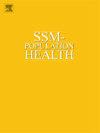Does partnership predict mortality? Evidence from a twin fixed effects study design
IF 3.1
2区 医学
Q1 PUBLIC, ENVIRONMENTAL & OCCUPATIONAL HEALTH
引用次数: 0
Abstract
This study examines the association between partnership status and mortality, addressing methodological concerns such as selection effects and unobserved heterogeneity. Utilizing Norwegian administrative data on birth cohorts from 1955 to 1975, we analyze mortality outcomes using Kaplan-Meier survival analyses and Cox proportional hazards regression models. The dataset includes over 1.2 million individuals and distinguishes between partnered and non-partnered individuals. While results for the general population show that non-partnered individuals face significantly higher mortality risks, with hazard ratios of 1.59 for men and 1.47 for women, twin fixed effects models reveal no significant relationship between partnership status and mortality. This finding suggests that much of the observed association may be due to shared genetic and environmental factors rather than a direct causal effect of partnership status. By leveraging the twin fixed effects research design, this study provides a robust test of the partnership-mortality hypothesis, highlighting the importance of controlling for unobserved heterogeneity in observational research. Our results underscore the complexity of the partnership-health nexus and call for caution in interpreting simple associations as evidence of causality.
伴侣关系能预测死亡率吗?来自双胞胎固定效应研究设计的证据
本研究探讨了伴侣关系状态和死亡率之间的关系,解决了方法上的问题,如选择效应和未观察到的异质性。利用挪威1955年至1975年出生队列的行政数据,我们使用Kaplan-Meier生存分析和Cox比例风险回归模型分析死亡率结果。该数据集包括超过120万个人,并区分了有伴侣和无伴侣的个人。虽然对一般人群的研究结果显示,无伴侣个体面临的死亡风险明显更高,男性的风险比为1.59,女性的风险比为1.47,但双胞胎固定效应模型显示,伴侣状态与死亡率之间没有显著关系。这一发现表明,大部分观察到的关联可能是由于共同的遗传和环境因素,而不是伙伴关系状态的直接因果影响。通过利用双胞胎固定效应研究设计,本研究为伙伴关系-死亡率假设提供了强有力的检验,强调了在观察性研究中控制未观察到的异质性的重要性。我们的研究结果强调了伙伴关系与健康关系的复杂性,并呼吁在将简单的关联解释为因果关系的证据时要谨慎。
本文章由计算机程序翻译,如有差异,请以英文原文为准。
求助全文
约1分钟内获得全文
求助全文
来源期刊

Ssm-Population Health
PUBLIC, ENVIRONMENTAL & OCCUPATIONAL HEALTH-
CiteScore
6.50
自引率
2.10%
发文量
298
审稿时长
101 days
期刊介绍:
SSM - Population Health. The new online only, open access, peer reviewed journal in all areas relating Social Science research to population health. SSM - Population Health shares the same Editors-in Chief and general approach to manuscripts as its sister journal, Social Science & Medicine. The journal takes a broad approach to the field especially welcoming interdisciplinary papers from across the Social Sciences and allied areas. SSM - Population Health offers an alternative outlet for work which might not be considered, or is classed as ''out of scope'' elsewhere, and prioritizes fast peer review and publication to the benefit of authors and readers. The journal welcomes all types of paper from traditional primary research articles, replication studies, short communications, methodological studies, instrument validation, opinion pieces, literature reviews, etc. SSM - Population Health also offers the opportunity to publish special issues or sections to reflect current interest and research in topical or developing areas. The journal fully supports authors wanting to present their research in an innovative fashion though the use of multimedia formats.
 求助内容:
求助内容: 应助结果提醒方式:
应助结果提醒方式:


